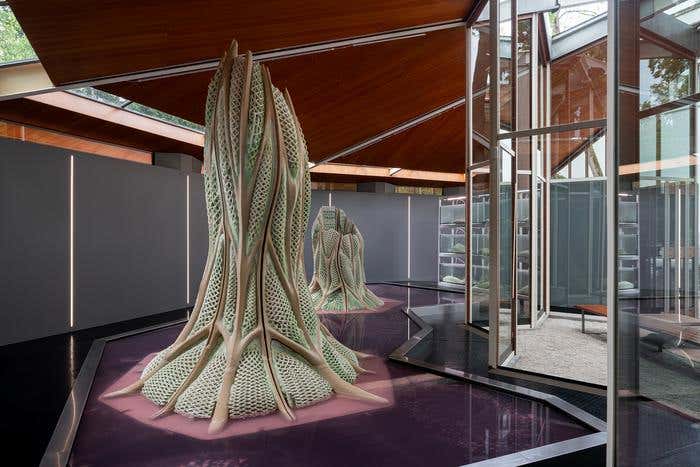Amazing 3D-printed material can grow, breathe, and remove CO2 from the air
ETH Zurich’s living materials use bacteria to trap CO2, offering a low-energy, sustainable building solution that grows over time.

Picoplanktonics shows large-format objects made of photosynthetic structures. (CREDIT: Valentina Mori/ Biennale di Venezia)
At ETH Zurich, scientists from many different fields are working on something that seems straight out of science fiction. They are creating materials that are not just built, but alive. These materials are designed to work with microorganisms like bacteria, algae, and fungi to perform useful tasks—like pulling carbon dioxide (CO2) from the air.
Mark Tibbitt, a professor of macromolecular engineering at ETH Zurich, has led a team of researchers in making this idea real. In a recent study published in Nature Communications, they shared their breakthrough: a 3D-printable gel filled with cyanobacteria, also called blue-green algae. This "living material" can grow, breathe, and remove CO2 from the air around it.
Carbon-Capturing Structures
The material works by combining biology and design. It uses cyanobacteria, which are among the oldest and most efficient photosynthetic organisms on Earth. These bacteria turn CO2 and water into biomass using even very weak light. But the special ability of these cyanobacteria goes beyond photosynthesis.
As the bacteria grow, they change their surroundings. They create an alkaline environment that causes minerals like calcium carbonate—a form of solid carbon—to form. This mineral buildup is more stable than the carbon stored in biomass alone. Over time, this makes the material harder, stronger, and capable of holding carbon permanently.
In tests, the material kept absorbing CO2 for over a year. On average, it stored around 26 milligrams of CO2 per gram of material over 400 days. That’s a lot more than other natural or bio-based systems, and it rivals some chemical methods of carbon capture.
According to co-lead author Yifan Cui, a doctoral student at ETH, "We use this ability specifically in our material." The minerals not only store CO2 but also reinforce the structure. So, over time, the soft gel turns into something much stronger—all thanks to the bacteria living inside.
Related Stories
Hydrogels Make It Possible
The team created a habitat for the cyanobacteria using a hydrogel. This is a soft, water-rich polymer that can hold cells in place while allowing light, water, and nutrients to pass through. The design ensures that the bacteria are evenly spread and well-fed inside the structure.
By using 3D printing, the scientists were able to build shapes that maximize surface area. This helps the bacteria get more light and nutrients, which keeps them active for longer periods. Dalia Dranseike, another lead author, explained, "We created structures that enable light penetration and passively distribute nutrient fluid throughout the body by capillary forces."
This approach worked well. The bacteria stayed productive for more than a year without needing special care. The gel stayed transparent enough to allow light in, and the entire system could operate on just sunlight, CO2, and a simple nutrient mix that mimics seawater.
The bacteria used in the material—Synechococcus sp. PCC 7002—are known for their fast growth and strong photosynthetic abilities. They can increase CO2 inside their cells up to 1000 times higher than the air around them, making them ideal for carbon capture.
From Labs to Architecture
Beyond the lab, this living material is starting to appear in real-world projects. ETH doctoral student Andrea Shin Ling helped build two installations using these materials: one at the Venice Architecture Biennale and another at the Triennale di Milano.
In Venice, the installation called Picoplanktonics used the material to build two large, tree-like structures. Each can capture up to 18 kilograms of CO2 per year—about as much as a 20-year-old pine tree. Ling explained, "It was particularly challenging to scale up the production process from laboratory format to room dimensions."
The team carefully adjusted the space in the Canada Pavilion so that the cyanobacteria would get enough light and humidity. They maintain the installation daily and monitor how the organisms behave in a public setting.
In Milan, the Dafne's Skin project looked at the aesthetic side of microbial design. Wooden shingles covered in living material grow a green patina as cyanobacteria spread. What would usually be seen as decay becomes a living layer that stores carbon and transforms the surface.
These early steps show how the material could be used in architecture to make buildings part of the climate solution. Mark Tibbitt sees a big future ahead: "We want to investigate how the material can be used as a coating for building facades to bind CO2 throughout the entire life cycle of a building."
A Low-Energy, High-Impact Solution
Natural carbon sinks, like forests and oceans, work slowly but steadily to trap CO2. They are cost-effective and operate without much human input. However, they don’t always grow fast enough to keep up with emissions, and it's hard to control them outside their normal habitats.
In contrast, engineered living materials like this one offer something new. They combine the best parts of biology—like adaptability and low energy needs—with the predictability and control of modern technology. Plus, this method doesn’t need toxic chemicals or extreme conditions. It runs on sunlight, air, and basic nutrients.
Other methods, like ureolytic microbially-induced carbonate precipitation (MICP), also use bacteria to form minerals. But they often create toxic by-products like ammonia and require tight environmental control. Photosynthetic MICP avoids these problems. It works cleanly, safely, and continuously, as long as the bacteria get light.
Over 30 days, the ETH Zurich team's material showed a steady buildup of both biomass and solid carbonates. The gel held the bacteria in place while allowing carbon to flow in from the air. Inside the hydrogel, cells grew into visible clusters, and solid carbon deposits became stronger and more widespread.
The team used specialized staining to prove that calcium carbonate was forming. Red coloring showed up inside the gels over time, indicating mineral buildup. These minerals stayed locked in place even after the organic parts were removed through heat.
The bacteria not only helped grow the material, they also made it stronger. As the minerals formed, they hardened the soft gel into a composite that can stand on its own. This makes the material easier to handle, store, and use in real construction projects.
Looking Forward
This technology is still in its early stages, but it shows promise. If future versions can be scaled up, living materials like this could become part of everyday buildings. They could coat walls, roofs, or even form the structures themselves. Unlike traditional materials, they would continue working over time, cleaning the air and storing carbon.
By mixing biology with smart design, researchers at ETH Zurich have taken a big step toward buildings that do more than just stand still. They breathe, grow, and help heal the planet. This is a bold new direction in both science and architecture—and it may be just the beginning.
Note: The article above provided above by The Brighter Side of News.
Like these kind of feel good stories? Get The Brighter Side of News' newsletter.



